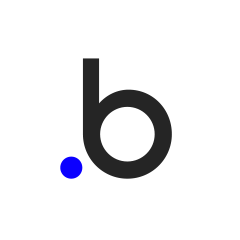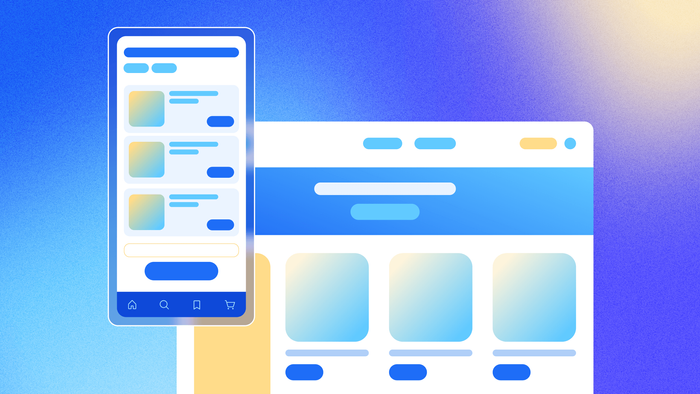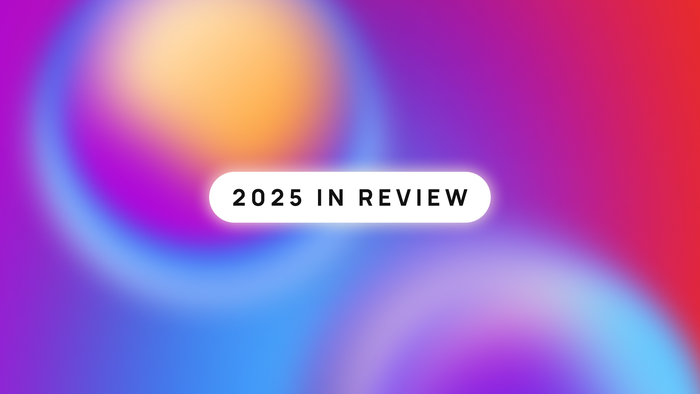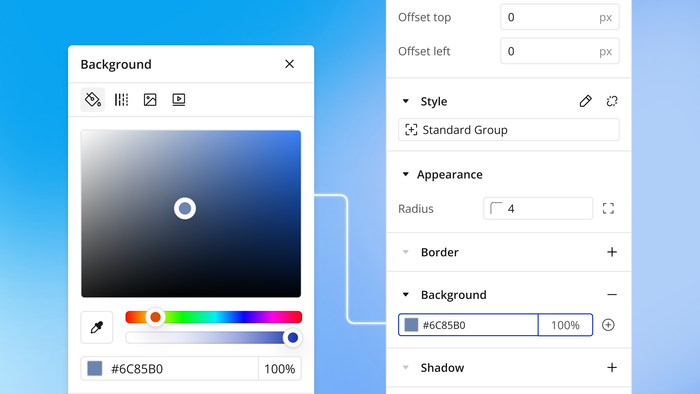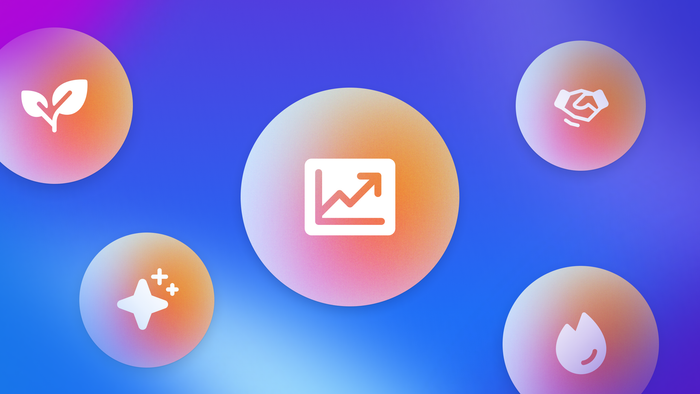Building for web and mobile often starts with the same goal: creating a great product experience. But when it comes to actually developing those apps, you're usually forced to choose between separate tools, workflows, and platforms — one for web, another for mobile. Until now, there hasn’t been a simple way to build both in one place.
That’s where Bubble comes in.
In this article, we’ll explore the key differences between web and native mobile development — and how Bubble makes it possible to design, build, and launch both from a single, unified platform. Whether you’re starting from scratch or bringing an existing web app to mobile, Bubble helps you do more with less friction.
If you’re already familiar with the differences between traditional web and mobile development, skip here to just read about the differences on Bubble or jump here for our tips on how to prepare to start building.
What’s the difference between a web app and a mobile app?
Web apps and mobile apps are often confused for one another, but they’re very different.
Web apps are applications that run in a browser and can be accessed via a URL. For example, consider LinkedIn when you access it from your computer. A native mobile app, on the other hand, is designed specifically for mobile devices, installed through app stores, and built to take full advantage of device features like push notifications, location services, and offline access. That would be LinkedIn’s mobile app, which is downloaded to your phone from the app store and taps into features like the camera, GPS, and push notifications.
Web vs. mobile app development: key differences
Web development and app development rely on the same foundational principles, but the way the finished apps are delivered to end users — and how those end users interact with them — shapes the development process for each.
Underlying technologies
The core technologies used for building web and mobile applications differ significantly, with each optimized for its respective platform.
Web applications: Unlike mobile apps, which must be installed on a user’s device, web apps run in a browser via URL and rely on a combination of frontend and backend programming languages to function, like HTML (HyperText Markup Language), CSS (Cascading Style Sheets), and JavaScript.
Native mobile applications: Unlike web apps, native mobile apps are designed to run directly on a device’s operating system (iOS or Android), offering a smoother, better experience. These apps are built using programming languages like Swift, Kotlin, or a framework that enables cross-platform development like React Native or Flutter.
Distribution and deployment
The fundamental differences in distribution and deployment shape how web and mobile applications reach and update their users:
Web applications: Web apps are accessed through web browsers via URLs. Deployment involves hosting the application on a server, and updates can be pushed live instantly, ensuring all users have immediate access to the latest version.
Native mobile applications: Native mobile apps must comply with app store (Apple's App Store and Google Play Store) guidelines and require approval processes. Mobile apps also have to be manually updated by the end-user (or their device, if they have auto-updates turned on).
UX/UI best practices
People interact with mobile apps differently than they interact with the web, which informs distinct design and user interface approaches.
Native mobile apps: Users interact primarily through touch rather than mouse clicks, using gestures like swiping, pinching, and long-pressing instead of hover states or right-clicks. New mobile app developers should consider which interactions in your favorite apps feel intuitive — like pull-to-refresh and bottom navigation bars within thumb reach.
Web apps: Web apps rely on mouse precision, keyboard input, and hover interactions that don’t translate directly to mobile experiences. Web developers must create responsive layouts that adapt to different screen sizes, with menus and interactive elements that work seamlessly across desktop and mobile browsers.
Access to device features
The capabilities of a user’s device that native mobile and web applications access can dictate the depth and breadth of user experiences:
Native mobile apps: Native apps have comprehensive access to device hardware and OS (operating system) features, including cameras, microphones, location services, push notifications, contacts, calendars, and more. This deep integration allows for richer functionality and seamless interaction with other installed apps.
Web apps: Web apps have more limited device access, though Progressive Web Apps (PWAs) have expanded capabilities. They can access location data, cameras, and microphones with user permission, but typically don’t have the same native look and feel users are expecting from a mobile app.
Native mobile vs. web app development on Bubble
While there are key differences between web and mobile development, building for both on Bubble offers a familiar, streamlined experience. In this section, we’ll walk through how Bubble adapts to the unique demands of mobile app development — making it intuitive without sacrificing power.
Your existing Bubble web app gives you a head start. All your backend logic, workflows, and database structures carry over to mobile, so you can build faster and preserve your work. Bubble also helps you create marketplace-ready apps that meet App Store and Google Play requirements, guiding you from development to launch.
And with built-in support for Apple’s Human Interface Guidelines and Google’s Material Design, your app will feel truly native, not just a web app in a mobile shell.
Let’s take a closer look at how mobile and web development differ — and how Bubble bridges the gap.
Interaction patterns: clicks vs. touch
The way users interact with apps changes depending on the device. On the web, clicks are the main mode of interaction. Dropdowns, hover effects, and mouse-driven controls work well in this environment, where users are navigating with precision.
Mobile apps, on the other hand, are all about touch. Bubble’s mobile builder supports gestures like taps, swipes, and long presses, creating a smooth, intuitive experience for users on the go. Instead of dropdowns, you’ll often use bottom sheets or selectable lists — components designed to be easy to use on smaller screens.
Bubble’s mobile builder supports gestures like taps, swipes, and long presses.
Displaying data: repeating groups vs. native lists
If you’ve used repeating groups to display content on the web, you’re already familiar with one of Bubble’s core tools for dynamic data. They’re great for layouts where you want to show a lot of information efficiently.
For mobile apps, Bubble introduces native list views — including vertical lists and section lists — that are built for performance and usability on phones and tablets. Whether you’re displaying a full feed or just a handful of items, these components help your app feel fast, organized, and truly mobile-first.
Native list views, including vertical lists and section lists, are built for performance and usability on phones and tablets.
Navigation: pages vs. tabs, stacks, and modals
Navigation works differently depending on the platform, and Bubble adapts to each with tools that feel natural to users. On the web, navigation is typically page-based. Users click through menus in headers, footers, or sidebars, and browser URLs update as they move through your app.
In mobile apps, navigation is more layered and gesture-based. Instead of loading new pages, views are stacked on top of each other or opened as modals, keeping the experience fluid and intuitive.
Bubble’s mobile builder supports three core navigation patterns: tab navigation, stack navigation, and modals.
Tab navigation is perfect for your app’s main sections (like settings and home). These tabs live at the bottom of the screen and feature icon buttons for easy, always-visible access.
Stack navigation lets users move deeper into your app while preserving history, with a built-in “back” button that returns them to the previous screen.
Stack navigation lets users move deeper into your app while preserving history.
Modals are great for focused tasks like editing a profile or submitting a form — they appear on top of your current view without disrupting your place in the app.
Modals are great for focused tasks like editing a profile or submitting a form
You’ll also find mobile-native components like bottom sheets, which can be used instead of traditional popups to display extra content or options in a clean, swipe-up panel. Each of these patterns helps you create a modern, mobile-first flow that feels polished and easy to use.
Bottom sheets can be used instead of traditional popups to display extra content
Embedded content: web views vs. native components
There may be times when you want to bring your existing web content into your mobile app. Bubble makes this easy with the web view element, which lets you embed web pages directly inside a mobile screen. It’s a helpful option when you’re transitioning from web to mobile or need quick access to already-built pages.
That said, we recommend leaning into Bubble’s native components whenever possible. They’re more performant and designed specifically for touch-based interfaces.
Plugins and frameworks
Bubble gives you access to a rich ecosystem of plugins, whether you’re building for web or mobile. On the web, most plugins rely on JavaScript to handle dynamic behavior and interactive features.
For mobile apps, Bubble leverages the React Native framework. This means you’ll be using mobile-optimized plugins that tap into native functionality and feel right at home on a device — from camera access to gestures and beyond.
How to get ready for the release of Bubble’s native mobile app builder
Native mobile apps on Bubble will be available to everyone in June! To help you get ready, we’ve gathered tips from beta users who’ve been testing the platform firsthand. Here’s how you can prepare to build a smooth, native mobile experience using Bubble.
Familiarize yourself with mobile design
Designing mobile apps requires a different approach than designing web apps. So getting inspiration from top-performing mobile apps can be key to helping you refine your UX.
Here are a few places to get some design inspiration:
- Page Flows: Great for entire UX flows, like signing up, booking, or making a purchase.
- Pttrns: Offers categorized iOS and Android app screens, with a focus on specific patterns like onboarding, navigation, or forms.
- Mobbin: Browse a huge library of iOS and Android screens from top apps, categorized by screen type, pattern, or flow.
- UXArchive: Focuses on mobile UX flows from top apps (like onboarding, sign-up, booking, etc.) with side-by-side comparisons.
“I love Mobbin for design inspiration. It’s also very comprehensive with how many examples it has, and it allows you to copy to Figma really easily.” — Mike, Minimum Studio
Master existing Bubble capabilities
One of the great advantages of building with Bubble is the fact that your web and mobile apps can share the same backend, including backend workflows, database, and API connections.
A key area to focus on as you prepare for mobile development is backend workflows. Mastering backend workflows will allow you to:
- Run processes on Bubble’s server instead of the user’s device
- Share logic across both web and mobile apps
- Improve performance and efficiency
“To me, the biggest highlight of building native mobile apps within Bubble is doing everything within the same ecosystem. So far, Bubble’s mobile builder has been so much easier to use than trying to wrap a web app with plugins. They just never quite feel native. As far as similarities, everything you know about logic, workflows, and elements still applies when transitioning from web to mobile.” — Justin Kyser, LRS Healthcare
Understand app store guidelines
A key part of launching a native mobile app is getting approved by Apple’s App Store and Google Play Store. Knowing the submission requirements in advance can help avoid delays.
Here are a few key guidelines to keep in mind:
- Apple Store: Apple enforces high standards for polished UI, functionality, and user experience. Apple also requires detailed privacy disclosures, permission prompts, and fully functional apps — no placeholders or MVP-style submissions allowed.
- Google Play Store: Google tends to be a bit more flexible with design but still requires details about your app’s content, audience, privacy and security practices, and more.
“Everything went through smoothly, and the app was approved and published much faster than we anticipated — even on the same day of submission. It was an exciting and unexpected milestone for us! For first-time developers, though, it’s helpful to understand the requirements for creating developer accounts, preparing app assets, and ensuring compliance with platform guidelines to avoid delays.” — Rokas, Idea Link
Review Bubble’s native mobile documentation
Reading through the manual can give you a solid understanding of what’s possible with native mobile on Bubble and how to structure your app efficiently.
We’ve put together comprehensive documentation to guide you through native mobile development and recommend checking out sections like:
- Differences in native and web elements: Dig into views, navigation types, sheets, lists, dropdowns, and more.
- Previewing mobile apps: Learn about web app preview and BubbleGo.
- Deploying mobile apps: Discover the differences between OTA vs. build updates, learn how to manage multiple live versions of your app, and more.
Build for as long as you want on the Free plan. Only upgrade when you're ready to launch.
Join Bubble